- Home
- Isaac Asimov
In the Beginning Page 14
In the Beginning Read online
Page 14
Naturally, the member of a numerous and powerful tribe will want to be sure that everyone who casually encounters him knows that he is not someone who might be harmed with impunity. The tribesman therefore wears his tribal tattoo (as a modern traveler carries a passport) as identification.
In later times, there was the tribe of Kenites. who were not Israelites but who lived in close association with the tribe of Judah (see Judges 1:16). The Kenites were a nomadic tribe of whom Cain was the eponymous ancestor (a real or mythical individual from whom a tribe or a people takes its name).
This portion of the Cain legend may be a fragment of a Kenite tale about how the tribal tattoo-mark came into being, although we may suppose that the Kenites did not portray their ancestor as a murderer.
16 And Cain went out from the presence of the Lord, and dwelt in the land of Nod, 151 on the east of Eden.
151. There is no land known as Nod. The word, in Hebrew, means “wandering,” so that to say that Cain “dwelt in the land of Nod” would seem to be a metaphorical way of saying that he became a wanderer, a nomad.
“Nomad,” by the way, has nothing to do with “Nod.” Nomad is from a Greek word meaning “to seek for pasture.”
17 And Cain knew his wife; 152 and she conceived, and bare Enoch: and he builded a city, 153 and called the name of the city, after the name of his son, Enoch.154
152. Where did Cain get his wife?
A common assumption is that Adam and Eve had daughters as well as sons but that daughters routinely went unmentioned in the Bible. In that case, Cain married his sister, a case of incest there was no way of avoiding. (After all, Adam married his own clone.)
Another possibility is the one mentioned in connection with Cain’s fear of being killed as an outlaw—that numerous pre-Adamites existed and that Cain married one of those.
It is most reasonable to suppose that the legends of Cain deal with a primordial already-populated world, and that the legends were artificially connected to the Adam-and-Eve story, thus creating difficulties.
153. Immediately after Cain is described as taking up a wandering life in accordance with the avenging word of God, he settles down to build a city. Apparently, we are back to Cain, the farmer, of the first eight verses of the chapter.
Farming communities inevitably built cities, since the farmers had to huddle together for protection. Unlike herdsmen, they could not move about; they could not drive their herds ahead of them and move away when over conditions seemed to grow insecure, They were nailed to the spot by their farms and had to protect those farms and themselves.
To have Cain, the farmer, build a city, therefore, makes sense. Naturally, to build a city implies a population. Even a very small and very primitive city would have a couple of hundred people in it. Therefore, those who are puzzled by the identity of Cain’s wife would do better to puzzle over the identity of the people who populated Cain’s city.
154. There is no city we know of in very early times by the name of Enoch, or anything recognizably like it. Nor is the city referred to elsewhere in the Bible.
In actual history, one of the oldest cities to be founded (or even, perhaps, the very oldest) is a city well known to the Biblical writers. It was Jericho, located twenty-five kilometers (fifteen miles) northeast of Jerusalem and frequently mentioned in the Bible. It may have come into existence about 8000 B.C.
There is absolutely no reason to suppose, however, that Enoch represents Jericho.
18 And unto Enoch was born Irad: and Irad begat Mehujael: and Mehujael begat Methusael: and Methusael begat La-mech.155
155. The Biblical writers are interested in genealogies for three reasons.
First, family relationships of all degrees are important in tribal societies. Genealogies serve to fit various individuals into appropriate slots.
Second, genealogies fill up gaps. Those portions of history concerning which nothing of interest (or even nothing at all) can be related are quickly disposed of by simply listing a line of descent.
Third, genealogies are a way of quickly describing and being done with the history of a tribe or group of tribes that is not ancestral to the Israelites (with whom the Biblical story primarily deals). Cain and his progeny are thus disposed of, since none of them are in the line of Israelite ancestry.
Because of the free use in the King James Version of the word “begat,” meaning “procreated” or “sired” (not really “gave birth to” since that is the prerogative of the female of the species), such passages are colloquially known as “the begats.” The word is eliminated in the Revised Standard Version, which has the verse read: “To Enoch was born Irad; and Irad was the father of Mehujael; and Mehujael the father of Methusael, and Methusael the father of Lamech.”
19 And Lamech took unto him two wives: 156 the name of the one was Adah, and the name of the other Zillah.157
156. This is the first mention of polygamy in the Bible, and there is no clear indication that it is viewed with disapproval, either here or in any of the other historical books of the Bible prior to the Babylonian exile.
157. These are the first women named in the Bible—or even mentioned—since Eve. All through the Bible there is a vast disproportion in the number of men and women mentioned, as there is in non-Biblical histories. The world has long concerned itself with men almost exclusively.
20 And Adah bare Jabal: he was the father of such as dwell in tents, and of such as have cattle.158
158. Here we have a brief reference to another legend concerned with the beginnings of herding, which eighteen verses earlier had been attributed to Abel. The names of Abel and Jabal are sufficiently similar, however, to make one wonder whether the two accounts are not different versions of the same legend. (Again one must ask as to the uses of herding where human beings are restricted to a vegetarian diet. One answer might be for skins, leather, and wool for clothing. Of course, one might also argue that the line of Cain broke the divine edict in line with the growing sinfulness of humanity-but the Bible doesn’t say so directly.)
21 And his brother’s name was Jubal: he was the father of all such as handle the harp and organ.
22 And Zillah, she also bare Tubal-cain, 159an instructer of every artificer in brass 160 and iron 161: and the sister of Tubal-cain was Naamah.162
159. The mention of Tubal-cain strengthens the possibility that we have here a second version of the same legend given at the beginning of the chapter. At the start of the chapter we have two brothers—Abel, the herdsman, and Cain, the farmer. Here we have Jabal, the herdsman, and Tubal-cain, the metallurgist. This time around there is no conflict or murder described; the Bible concentrates on the two as “culture-heroes,” that is, as originating some line of human activity.
160. The Hebrew word nehosheth is translated as “brass” in the King James Version. More correctly, it should be translated as “copper” or “bronze.” The earliest use of copper for ornamentation was soon after 4000 B.C. Alloyed with arsenic or tin, copper could be made hard enough to be used in tools or weapons, and this alloy was called bronze. By 3000 B.C. bronze was coming into use. By Biblical standards, the period 4000-3000 B.C. was the dawn of history, so the association of copper with Tubal-cain is reasonable.
161. The name Tubal-cain means “smith of Tubal,” Tubal being a district in Asia Minor on the southeast shore of the Black Sea. As a matter of fact, the techniques of iron smelting and ironworking were first developed in the neighborhood of that region, so the association of Tubal-cain with iron is a good one.
However, iron was first smelted about 1300 B.C., and it did not come into general use for some centuries afterward. To lump iron with copper in the time of Tubal-cain is an anachronism.
162. This chapter, which is part of the J-document, lists eight generations, starting with Adam: (1) Adam, (2) Cain, (3) Enoch, (4) Irad, (5) Mehujael, (6) Methusael, (7) Lamech, and (8) Lamech’s children.
There were lists of early kings in the Tigris-Euphrates region concerning whom nothin
g was reported but their names. A very early list compiled by the Sumerians listed eight names, but these names are very different from those in this chapter. Conceivably, as the legends were told and retold, the Sumerian names may have been altered to Hebrew equivalents in a folk-etymological manner and ended up in the J-document as we now have them.
23 And Lamech 163 said unto his wives, Adah and Zillah, Hear my voice; ye wives of Lamech, hearken unto my speech: for I have slain a man to my wounding, and a young man to my hurt.164
163. Lamech seems to have importance. He has two wives, three sons, and a daughter, all of whom are named, even the daughter. And now a short poem is about to be attributed to him. Lamech may have been a Kenite folk-hero, and some of the deeds attributed to him are borrowed by the J-document, perhaps because tales of him were so popular in Judah that he had to be incorporated into the Judean account of primeval history.
164. The second part of the verse is obscure in the King James Version. The Revised Standard Version has it read. “I have slain a man for wounding me, a young man for striking me.”
The reference is probably to a single feat of killing. Hebrew poetry achieves its effects very often by “parallelism”; that is, by saying the same thing in two slightly different ways. The J-document may here be incorporating an old Kenite war song.
24 If Cain shall be avenged seven fold, truly Lamech seventy and sevenfold.165
165. Lamech seems jubilant over his victory, indicating that he considers his killing to be superior to that of Cain. Perhaps (the Bible doesn’t say, of course) he was thinking that Cain slew an unprepared and unarmed man, while he himself may have killed an armed man in a duel.
Certainly, this would seem to be an indication that in the course of the eight generations from Adam, human conflict had progressed from individual fighting to organized war. There seems to be a continued moral deterioration of humanity after the expulsion from the Garden, at least in the line of Cain.
With this victory song as climax and as evidence of degradation, the J-document leaves the descendants of Cain at this point. They are abandoned as unsuitable to be discussed further. The tale turns to another line descended from Adam.
25 And Adam knew his wife again; and she bare a son, and called his name Seth: For God, said she, hath appointed 166 me another seed instead of Abel, whom Cain slew.
166. The name Seth sounds like the Hebrew word for “appointed” or “granted,” so that Eve is made to give him the name in a folk-etymological manner.
26 And to Seth, to him also there was born a son; and he called his name Enos: 167 then began men to call upon the name of the Lord.168
167. The two brothers, Cain and Seth, had sons of similar names: Enoch and Enos (in Hebrew Hannoch and Enosh). It may be that the descendants of Seth are also derived from the Sumerian king-lists, so that the two lines of descent from Adam, by way of Cain and by way of Seth, represent two different versions of the Sumerian sources.
168. This would seem to mean that instead of worship ping a nameless god or some false one, people in the time of Enos began to worship Yahveh. According to the J-document, at least, this would indicate the beginning of Yahvism (out of which Judaism, Christianity, and Islam all developed).
The J-document, in this chapter, thus clearly distinguishes between the two lines of descent from Adam. The line of Cain was marked by murder, polygamy, the development of metal weapons, and warfare. The line of Seth, on the other hand (from which the Israelites were descended, by the Biblical account), was marked by the development of true religion.
Chapter 5
1 This is the book of the generations of Adam. 169 In the day that God 170 created man, in the likeness of God made he him:
169. This is an introductory phrase that introduces a new section; one that bears little connection with what has immediately preceded.
170. The use of “God” instead of “the Lord” or “Lord God” shows that we are back in the P-document after three chapters of J-document.
2 Male and female created he them; and blessed them, 171 and called their name Adam, 172 in the day when they were created.
171. The P-document harks back to the point where it left off at the beginning of Chapter 2. It skips over the whole tale of the Garden of Eden, of Eve and the serpent, of Cain and Abel, of the descendants of Cain. It does not deal with them and, apparently, knows nothing of them.
172. The P-document again emphasizes the simultaneous creation of man and woman. It is not only the male who is called Adam (“man”), but both of them. Here the word adam is equivalent to “mankind” or “humanity.” It is still possible that a large number of men and women were created.
3 And Adam 173 lived an hundred and thirty years, 174 and begat a son in his own likeness, after his image; 175 and called his name Seth:
173. Now Adam is spoken of as an individual, but this does not necessarily mean that, in the P-document, only one man was created to begin with. We merely shift from mankind in general to one particular man from whom the line of the Israelites had its beginnings.
174. The J-document, in listing the descendants of Cain, gives no ages or time durations. The priestly writers of the P-document are more meticulous in these details.
175. The P-document makes no mention of Cain and Abel. If we consider the P-document only, Seth is the firstborn of Adam. This could explain the reference to “a son in his own likeness, after his image.”
In Genesis 1:26, we have “And God said, Let us make man in our image, after our likeness.” This could, conceivably, have applied only to the man and woman (or the men and women) directly created by God. By pointing out that Seth was born in Adam’s “own likeness, after his image,” and therefore in God’s, the indication would be that all Adam’s descendants and, therefore, all human beings are in God’s image. At least this would be true of all those of the line of Seth, and as we shall see later, that includes all of mankind.
Another possibility is that Seth may here be differentiated from the wicked Cain and his descendants. Cain was not in the image of Adam and therefore of God, but in that case, what about the virtuous Abel? It probably makes more sense not to try to mix the P-document and the J-document.
4 And the days of Adam after he had begotten Seth were eight hundred years: and he begat sons and daughters: 176
176. If Adam sired children as often as we do and had eight hundred years to do it in, he could easily have fathered four hundred sons and four hundred daughters. If each of these were equally long-lived and equally prolific. then in a mere four generations, twenty-five billion people would have been born.
In actual fact, the population of Earth in 3500 B.C. (roughly the time of the immediate generations after Adam, according to the traditional chronology) was about ten million—something that could easily have been managed if long-lived individuals had followed God’s blessing and edict that they “be fruitful and multiply, and replenish the earth.”
It might also solve some problems, since if Cain were equally long-lived, he needed only to wait some centuries, and then there would be plenty of people from among whom to choose a wife and with whom to build a city and, for that matter, from whom to expect harm.
In exchange, of course, we are faced with the problem of accounting for these long life-spans.
The P-document does not name the sons and daughters that Adam sired after Seth. It does the same in connection with each descendant in this chapter, naming only one son and ignoring all other children. It is the named sons who are the ancestors of the Israelites, All other lines of descent will not survive a coming catastrophe, and they are therefore ignored.
5 And all the days that Adam lived were nine hundred and thirty years; 177 and he died.
177. Adam and his descendants, according to the P-document (at least those descendants who are given names in this chapter), had extended lifetimes, living far longer than what we now recognize to be the maximum life-span of the human being (about 115 years).
As one progresses through the Bible, the life-span of human beings is described as gradually decreasing until, by the end of the Book of Genesis, 150 is recognized as extreme old age, and by the time of King David seventy is.
Could it be that early man lived long and that modern man’s short life-span is an example of degeneracy?
From the scientific standpoint, this is probably the reverse of the truth. Homo sapiens always had the capacity to live for a hundred years or a little more (a longer life-span than that of any other mammal), but in early time he almost never had the chance to do so. Life was brutal and chancy, and few people lived past forty. This was true right down to the middle of the nineteenth century.
Throughout historic times, there were cases of human beings living to be over ninety, according to reliable report—Sophocles in the fifth century B.C., Isocrates in the fourth century B.C., Cassiodorus in the sixth century, Titian in the sixteenth century, and so on—but they were comparatively few in number.
It was only after modern medicine was developed and infectious disease could be controlled that the average life-span began to increase.
Once people reach the age of sixty, it is the degenerative diseases that take their toll (cancer, arthritis, heart attack, strokes, kidney failure, and so on). These have not yet yielded to the blandishments of medicine, so that a man of sixty today has little more in the way of life expectancy than a man of sixty in the times of Sophocles, twenty-four hundred years ago. Of course, many more reach the age of sixty now than in those times.
If so, then how explain the extended life-spans of Adam and his immediate descendants?
Some have suggested that the “years” here given are really lunar months, since the calendar had not yet been extended to include the solar years. There are twelve and a third lunar months in a year, so that if Adam lived for 930 lunar months, that would be equivalent to about seventy-six years, which sounds right.

 The Return of the Black Widowers
The Return of the Black Widowers The Stars, Like Dust
The Stars, Like Dust Foundation
Foundation David Starr Space Ranger
David Starr Space Ranger I, Robot
I, Robot Puzzles of the Black Widowers
Puzzles of the Black Widowers Casebook of the Black Widowers
Casebook of the Black Widowers The Ugly Little Boy
The Ugly Little Boy Azazel
Azazel Pebble in the Sky
Pebble in the Sky Foundation and Empire
Foundation and Empire The Complete Robot
The Complete Robot Fantastic Voyage
Fantastic Voyage Foundation and Earth
Foundation and Earth The Naked Sun
The Naked Sun The Currents of Space
The Currents of Space Foundation's Edge
Foundation's Edge The Robots of Dawn
The Robots of Dawn Nightfall
Nightfall The Caves of Steel
The Caves of Steel Prelude to Foundation
Prelude to Foundation Nemesis
Nemesis Robot Dreams
Robot Dreams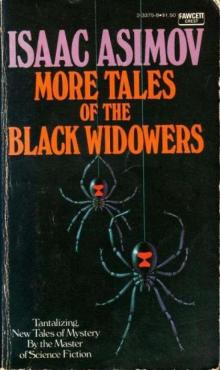 More Tales of the Black Widowers
More Tales of the Black Widowers The Complete Stories
The Complete Stories Robot Visions
Robot Visions Lucky Starr And The Moons of Jupiter
Lucky Starr And The Moons of Jupiter Lucky Starr and the Big Sun of Mercury
Lucky Starr and the Big Sun of Mercury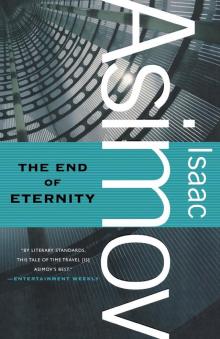 The End of Eternity
The End of Eternity The Bicentennial Man and Other Stories
The Bicentennial Man and Other Stories Lucky Starr And The Rings Of Saturn
Lucky Starr And The Rings Of Saturn Buy Jupiter and Other Stories
Buy Jupiter and Other Stories Forward the Foundation
Forward the Foundation Lucky Starr and the Oceans of Venus
Lucky Starr and the Oceans of Venus The Positronic Man
The Positronic Man The Portable Star
The Portable Star Asimovs Mysteries
Asimovs Mysteries Earth Is Room Enough
Earth Is Room Enough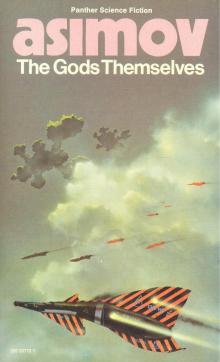 The Gods Themselves
The Gods Themselves Youth
Youth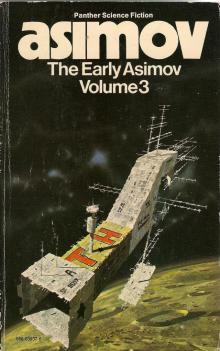 The Early Asimov Volume 3
The Early Asimov Volume 3 The Winds of Change and Other Stories
The Winds of Change and Other Stories Of Time, Space, and Other Things
Of Time, Space, and Other Things Nine Tomorrows
Nine Tomorrows Time Warps
Time Warps Robots and Empire
Robots and Empire Young Star Travelers
Young Star Travelers Fantastic Voyage II: Destination Brain
Fantastic Voyage II: Destination Brain Second Foundation
Second Foundation The Rest of the Robots
The Rest of the Robots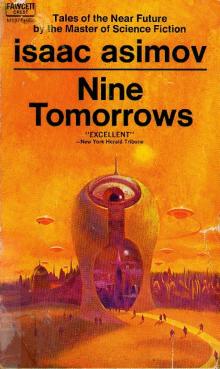 NINE TOMORROWS Tales of the Near Future
NINE TOMORROWS Tales of the Near Future Daneel Olivaw 1 - The Caves of Steel
Daneel Olivaw 1 - The Caves of Steel THE BICENTENNIAL MAN
THE BICENTENNIAL MAN David Starr Space Ranger (lucky starr)
David Starr Space Ranger (lucky starr)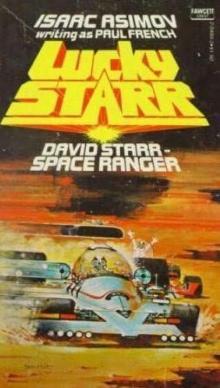 David Starr Space Ranger (ls)
David Starr Space Ranger (ls) Lucky Starr And The Big Sun Of Mercury ls-4
Lucky Starr And The Big Sun Of Mercury ls-4 Pebble In The Sky te-1
Pebble In The Sky te-1 Asimov’s Future History Volume 9
Asimov’s Future History Volume 9 Gold: The Final Science Fiction Collection
Gold: The Final Science Fiction Collection Foundation and Earth f-7
Foundation and Earth f-7 Asimov's New Guide to Science
Asimov's New Guide to Science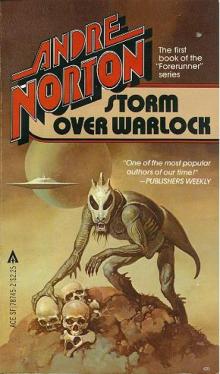 STORM OVER WARLOCK
STORM OVER WARLOCK Stars, Like Dust
Stars, Like Dust Norby The Mixed-Up Robot
Norby The Mixed-Up Robot Found!
Found! Asimov’s Future History Volume 11
Asimov’s Future History Volume 11 Second Foundation f-5
Second Foundation f-5 Asimov’s Future History Volume 15
Asimov’s Future History Volume 15 The Early Asimov. Volume 1
The Early Asimov. Volume 1 Secound Foundation
Secound Foundation Daneel Olivaw 3 - The Robots of Dawn
Daneel Olivaw 3 - The Robots of Dawn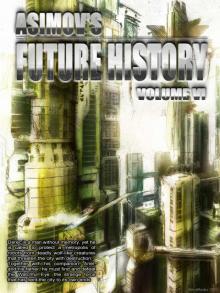 Asimov’s Future History Volume 6
Asimov’s Future History Volume 6 The Early Asimov. Volume 2
The Early Asimov. Volume 2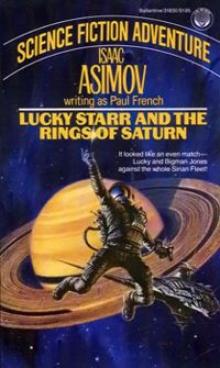 Lucky Starr And The Rings Of Saturn ls-6
Lucky Starr And The Rings Of Saturn ls-6 100 Malicious Little Mysteries
100 Malicious Little Mysteries Forward the Foundation f-2
Forward the Foundation f-2 I.Asimov: A Memoir
I.Asimov: A Memoir Foundation's Edge f-6
Foundation's Edge f-6 Lucky Starr and the Pirates of the Asteroids ls-2
Lucky Starr and the Pirates of the Asteroids ls-2 Robot City 1 & 2
Robot City 1 & 2 The Fourth Science Fiction Megapack
The Fourth Science Fiction Megapack Asimov’s Future History Volume 16
Asimov’s Future History Volume 16 The Dim Rumble
The Dim Rumble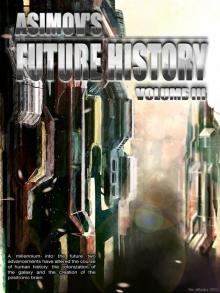 Asimov's Future History Volume 3
Asimov's Future History Volume 3 The Currents Of Space te-3
The Currents Of Space te-3 Asimov’s Guide To Shakespear. Volume 1
Asimov’s Guide To Shakespear. Volume 1 Asimov’s Future History Volume 13
Asimov’s Future History Volume 13 Asimov’s Future History Volume 12
Asimov’s Future History Volume 12 The Secret Sense
The Secret Sense Of Time and Space and Other Things
Of Time and Space and Other Things Norby tnc-2
Norby tnc-2 Norby The Mixed-Up Robot tnc-1
Norby The Mixed-Up Robot tnc-1 Misbegotten Missionary
Misbegotten Missionary Asimov’s Future History Volume 19
Asimov’s Future History Volume 19 Fantastic Voyage II: Destination Brain fv-2
Fantastic Voyage II: Destination Brain fv-2 Asimov’s Future History Volume 10
Asimov’s Future History Volume 10 Asimov's Future History Volume 2
Asimov's Future History Volume 2 Feeling of Power
Feeling of Power In the Beginning
In the Beginning The Caves of Steel trs-1
The Caves of Steel trs-1 Asimov's Future History Vol 2
Asimov's Future History Vol 2 Caliban c-1
Caliban c-1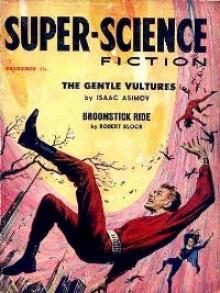 The Gentle Vultures
The Gentle Vultures Utopia c-3
Utopia c-3 Prelude to Foundation f-1
Prelude to Foundation f-1 Short Stories Vol.1
Short Stories Vol.1 Asimov’s Future History Volume 8
Asimov’s Future History Volume 8 Daneel Olivaw 4 - Robots and Empire
Daneel Olivaw 4 - Robots and Empire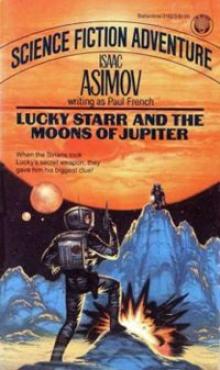 Lucky Starr The And The Moons of Jupiter ls-5
Lucky Starr The And The Moons of Jupiter ls-5 Gold
Gold Asimov’s Future History Volume 4
Asimov’s Future History Volume 4 Foundation and Empire f-4
Foundation and Empire f-4 Potential
Potential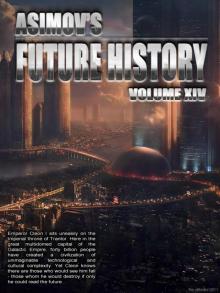 Asimov’s Future History Volume 14
Asimov’s Future History Volume 14 Asimov’s Future History Volume 7
Asimov’s Future History Volume 7 Daneel Olivaw 2 - The Naked Sun
Daneel Olivaw 2 - The Naked Sun Lucky Starr and the Pirates of the Asteroids
Lucky Starr and the Pirates of the Asteroids Foundation f-3
Foundation f-3 All the Troubles of the World
All the Troubles of the World Cleon the Emperor
Cleon the Emperor Asimov's Future History Volume 5
Asimov's Future History Volume 5 Asimov’s Future History Volume 20
Asimov’s Future History Volume 20 Robots and Empire trs-4
Robots and Empire trs-4 Profession
Profession It's Been a Good Life
It's Been a Good Life The Robots of Dawn trs-3
The Robots of Dawn trs-3 Lucky Starr And The Oceanf Of Venus ls-3
Lucky Starr And The Oceanf Of Venus ls-3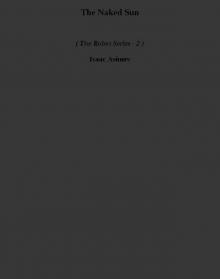 The Naked Sun trs-2
The Naked Sun trs-2 Asimov's Future History Volume 1
Asimov's Future History Volume 1